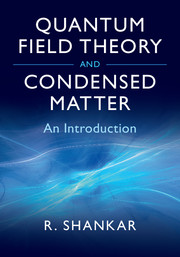Book contents
- Frontmatter
- Dedication
- Contents
- Preface
- 1 Thermodynamics and Statistical Mechanics Review
- 2 The Ising Model in d = 0 and d = 1
- 3 Statistical to Quantum Mechanics
- 4 Quantum to Statistical Mechanics
- 5 The Feynman Path Integral
- 6 Coherent State Path Integrals for Spins, Bosons, and Fermions
- 7 The Two-Dimensional Ising Model
- 8 Exact Solution of the Two–Dimensional Ising Model
- 9 Majorana Fermions
- 10 Gauge Theories
- 11 The Renormalization Group
- 12 Critical Phenomena: The Puzzle and Resolution
- 13 Renormalization Group for the ϕ4 Model
- 14 Two Views of Renormalization
- 15 Renormalization Group for Non-Relativistic Fermions: I
- 16 Renormalization Group for Non-Relativistic Fermions: II
- 17 Bosonization I: The Fermion–Boson Dictionary
- 18 Bosonization II: Selected Applications
- 19 Duality and Triality
- 20 Techniques for the Quantum Hall Effect
- Index
- References
3 - Statistical to Quantum Mechanics
Published online by Cambridge University Press: 24 October 2017
- Frontmatter
- Dedication
- Contents
- Preface
- 1 Thermodynamics and Statistical Mechanics Review
- 2 The Ising Model in d = 0 and d = 1
- 3 Statistical to Quantum Mechanics
- 4 Quantum to Statistical Mechanics
- 5 The Feynman Path Integral
- 6 Coherent State Path Integrals for Spins, Bosons, and Fermions
- 7 The Two-Dimensional Ising Model
- 8 Exact Solution of the Two–Dimensional Ising Model
- 9 Majorana Fermions
- 10 Gauge Theories
- 11 The Renormalization Group
- 12 Critical Phenomena: The Puzzle and Resolution
- 13 Renormalization Group for the ϕ4 Model
- 14 Two Views of Renormalization
- 15 Renormalization Group for Non-Relativistic Fermions: I
- 16 Renormalization Group for Non-Relativistic Fermions: II
- 17 Bosonization I: The Fermion–Boson Dictionary
- 18 Bosonization II: Selected Applications
- 19 Duality and Triality
- 20 Techniques for the Quantum Hall Effect
- Index
- References
Summary
We have thus far looked at the classical statistical mechanics of a collection of Ising spins in terms of their partition function. We have seen how to extract the free energy per site and correlation functions of the d = 1 Ising model.
We will now consider a second way to do this. While the results are, of course, going to be the same, the method exposes a deep connection between classical statistical mechanics in d = 1 and the quantum mechanics of a single spin-12 particle. This is the simplest way to learn about a connection that has a much wider range of applicability: the classical statistical mechanics of a problem in d dimensions may be mapped on to a quantum problem in d – 1 dimensions. The nature of the quantum variable will depend on the nature of the classical variable. In general, the allowed values of the classical variable (s=±1 in our example) will correspond to the maximal set of simultaneous eigenvalues of the operators in the quantum problem (σz in our example). Subsequently we will study a problem where the classical variable called x lies in the range –∞ < x < ∞ and will correspond to the eigenvalues of the familiar position operator X that appears in the quantum problem. The correlation functions will become the expectation values in the ground state of a certain transfer matrix.
The different sites in the d = 1 lattice will correspond to different, discrete, times in the life of the quantum degree of freedom.
By the same token, a quantum problem may be mapped into a statistical mechanics problem in one-higher dimensions, essentially by running the derivation backwards. In this case the resulting partition function is also called the path integral for the quantum problem. There is, however, no guarantee that the classical partition function generated by a legitimate quantum problem (with a Hermitian Hamiltonian) will always make physical sense: the corresponding Boltzmann weights may be negative, or even complex!
In the quantum mechanics we first learn, time t is a real parameter. For our purposes we also need to get familiar with quantum mechanics in which time takes on purely imaginary values t =–iτ, where τ is real. It turns out that it is possible to define such a Euclidean quantum mechanics.
Information
- Type
- Chapter
- Information
- Quantum Field Theory and Condensed MatterAn Introduction, pp. 29 - 44Publisher: Cambridge University PressPrint publication year: 2017
